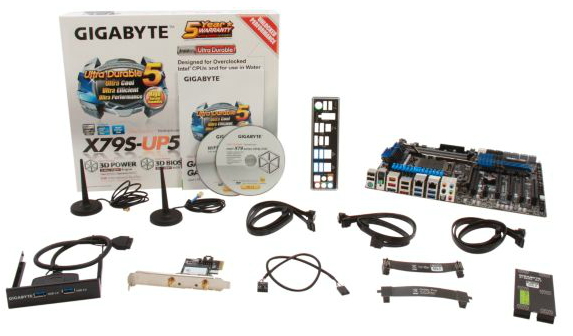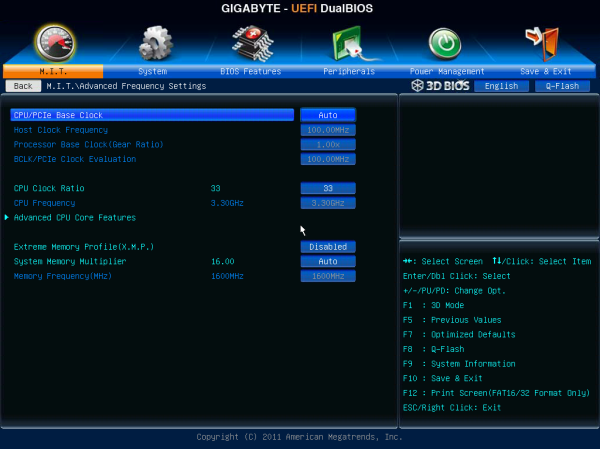Gigabyte X79S-UP5 WiFi Review: Ultra Durable 5 Meets the C606 Chipset
by Ian Cutress on September 6, 2012 6:36 PM EST- Posted in
- Motherboards
- Gigabyte
- X79
- C606
Gigabyte X79S-UP5 WiFi In The Box
Gigabyte's high-end packages of late have been overflowing with extras in the box. When we shell out over $300 for a product, there has to be something in the box that makes it worthwhile. In the case of the X79S-UP5 WiFi, we get:
Driver CD
WiFi CD
User Manual
Rear IO Place
Six SATA Cables
USB 3.0 Front Panel
PCIe x1 WiFi card
Two Antenna
USB to 4-pin Floppy Cable
Flexible Crossfire Connector
Flexible SLI Connector
Rigid 3-way SLI Connector

If we directly compare the box of the ASRock X79 Extreme11, a $600 product, to that of this $330 motherboard, they are essentially the same, except that the Gigabyte board comes with the WiFi card, antenna and other peripherals, but without some molex to SATA cables.
Gigabyte X79S-UP5 WiFi Overclocking
Experience with Gigabyte X79S-UP5 WiFi
For an X79 board, the Gigabyte X79S-UP5 WiFi has a few minor flaws when it came to overclocking. Namely at the time of the latest BIOS when this board was tested, neither the settings for Load Line Calibration or PLL overvoltages worked. (The first of these is to help stabilize voltage, the second is important for Sandy Bridge processors to work over 4.6 GHz.) Gigabyte is now aware of these, so they may be fixed in a later BIOS.
Despite a workstation board not having overclocking as a focus, Gigabyte employs two different features to ensure that a user can boost the CPU speed. The first is MultiCore Enhancement, which allows the processor to run at the top turbo bin no matter the loading (read this article to learn more about MCE), which becomes enabled when XMP is enabled. The next is the OC button on the back of the IO panel. When enabled (pressed down and light is on), the CPU gets a mild push in overclocks and voltages.
Automatic overclocking was a little flawed - the options available in EasyTune were not happy with various memory kits or even at their own settings. As this motherboard uses the C606 chipset, we also get no 'Auto Tuning' option, and Gigabyte Tweak Launcher does not work. For manual overclocks, the fact that the BIOS even when selected has trouble with LLC and PLL Overvoltage means there is a hard limit to overclocking. For example on the LLC front - when the BIOS is set to LLC Extreme and 1.400 volts, the CPU in the OS will register 1.356 volts at load, rather than ~1.400 volts as expected.
Methodology:
Our standard overclocking methodology is as follows. We select the automatic overclock options and test for stability with PovRay and OCCT to simulate high-end workloads. These stability tests aim to catch any immediate causes for memory or CPU errors.
For manual overclocks, based on the information gathered from previous testing, starts off at a nominal voltage and CPU multiplier, and the multiplier is increased until the stability tests are failed. The CPU voltage is increased gradually until the stability tests are passed, and the process repeated until the motherboard reduces the multiplier automatically (due to safety protocol) or the CPU temperature reaches a stupidly high level (100ºC+).
Our test bed is not in a case, which should push overclocks higher with fresher (cooler) air. We also are using Intel's All-in-one Liquid Cooler with its stock fan. This is a 120mm radiator liquid cooler, designed to mimic a medium-to-high end air cooler.
Automatic Overclock:
The options for automatic options come from the OC Button on the back IO panel of the motherboard, or the three options found in EasyTune 6. Here we go through them one by one.
When the OC button was enabled, the system would apply a different set of turbo bins to our processor. Instead of 39x/39x/38x/38x/37x/36x as expected, the system would boost single core performance to 4.2 GHz. This resulted in improved benchmark scores (131.49 in 3DPM Single Thread vs. 123.27 at stock) with no discernable increase in temperature.
Under ET6, the OC Level 1 option was selected - this gave the system a 41x multiplier and 102 MHz BCLK for a total overclock to 4182 MHz. This setting left both the BIOS voltage and CPU LLC on automatic. In the OS, we saw a load voltage of 1.296 volts, and XMP was applied automatically. This gave peak temperatures of 57ºC during PovRay and 60ºC during OCCT.
The OC Level 2 option gave the system a 43x multiplier and 103 MHz BCLK for a total overclock to 4429 MHz. This setting was stable during PovRay, giving 59ºC as a peak temperature, but produced errors during OCCT.
The OC Level 3 option should have applied a 44x multiplier and 104 MHz BCLK for a total overclock to 4576 MHz, however this setting was completely unstable and the board refused to POST.
Manual Overclock:
For our manual overclocking the BIOS is the place to go. By default, we enabled PLL Overvoltage (to enable overclocks above 4.6 GHz) and set the CPU Load Line Calibration to Extreme for CPU voltage stability. As with other testing, we started with the 44x multiplier.
At the 44x multiplier, the system was stable with a setting of 1.375 volts in the BIOS. This led to a reading of 1.332 volts at load in the OS, and peak temperatures of 62ºC during PovRay and 64ºC during OCCT.
At the 45x multiplier, the system was stable with a setting of 1.425 volts in the BIOS. This led to a reading of 1.380 volts at load in the OS, and peak temperatures of 66ºC during PovRay and 68ºC during OCCT.
At the 46x multiplier, no setting selected would boot successfully. The power limits were adjusted to 500W, the voltage in the BIOS upped to 1.500 volts, but the system refused to boot at all. This leads me to believe that the PLL Overvoltage setting in the BIOS is not properly configured, or is a limiting feature of the chipset as a whole that restricts the CPU.











16 Comments
View All Comments
jdonnelly - Thursday, September 6, 2012 - link
Seems to go to a different board, vice the board you're reviewing.IanCutress - Wednesday, September 12, 2012 - link
Hi all,Thanks for pointing this out - just a hangover from the html table template from the last review. Then I went on my honeymoon and came back to the emails and comments :) Thankfully the link in the Test Setup was correct :) It should all be fixed now...
Ian
DigitalFreak - Thursday, September 6, 2012 - link
The Newegg link in the board features table goes to the ASRock X79 board you reviewed last week. :-)earthrace57 - Thursday, September 6, 2012 - link
The link to newegg linked me to the ASRock Extreme 11 :)alcortez - Thursday, September 6, 2012 - link
http://www.newegg.com/Product/Product.aspx?Item=N8...apriest - Thursday, September 6, 2012 - link
I want Thunderbolt with more than 32GB RAM. How about 96-128GB RAM and Thunderbolt on the same single (or even dual) socket workstation board?The0ne - Thursday, September 6, 2012 - link
Where are the rest of the awards in the same category? Is there an easy place to find these? It would be helpful for people like me who don't have much time and trust your judgement to just pick between the them (bronze, silver, gold). Thanks.Rick83 - Friday, September 7, 2012 - link
That's a bit cheap.Probably no support for AMT either (but then few 2011 Xeons are vPro enabled, so it's not that bad)
A note to the editor: Please add the exact NIC name/number. There are so many different Intel NICs, and also a number of different Realtek NICs, that it's convenient to know which are used without having to crawl the web for the info, especially if the manufacturer's site conveniently omits that info.
You've got the board on hand, with all the device IDs, so go ahead and put that info on the spec-page.
Thanks.
Rick83 - Friday, September 7, 2012 - link
Another note:If a mainboard claims to support ECC-RAM, please do test if it actually does, and how so.
tiro_uspsss - Friday, September 7, 2012 - link
from my limited experience + what I have read here'n'there on the web, GB mobos suck with supporting RAID cards (LSI etc). With this product (& any other in the same catergory / market target), will GB finally address this issue?